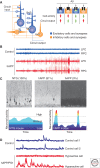Neurotoxicity of amyloid β-protein: synaptic and network dysfunction
- PMID: 22762015
- PMCID: PMC3385944
- DOI: 10.1101/cshperspect.a006338
Neurotoxicity of amyloid β-protein: synaptic and network dysfunction
Abstract
Evidence for an ever-expanding variety of molecular mediators of amyloid β-protein neurotoxicity (membrane lipids, receptor proteins, channel proteins, second messengers and related signaling cascades, cytoskeletal proteins, inflammatory mediators, etc.) has led to the notion that the binding of hydrophobic Aβ assemblies to cellular membranes triggers multiple effects affecting diverse pathways. It appears unlikely that there are only one or two cognate receptors for neurotoxic forms of Aβ and also that there are just one or two assembly forms of the peptide that induce neuronal dysfunction. Rather, various soluble (diffusible) oligomers of Aβ that may be in dynamic equilibrium with insoluble, fibrillar deposits (amyloid plaques) and that can bind to different components of neuronal and non-neuronal plasma membranes appear to induce complex patterns of synaptic dysfunction and network disorganization that underlie the intermittent but gradually progressive cognitive manifestations of the clinical disorder. Modern analyses of this problem utilize electrophysiology coupled with synaptic biochemistry and behavioral phenotyping of animal models to elucidate the affected circuits and assess the effects of potential therapeutic interventions.
Figures



References
-
- Abramov E, Dolev I, Fogel H, Ciccotosto GD, Ruff E, Slutsky I 2009. Amyloid-β as a positive endogenous regulator of release probability at hippocampal synapses. Nat Neurosci 12: 1567–1576 - PubMed
-
- Bitan G, Lomakin A, Teplow DB 2001. Amyloid β-protein oligomerization: Prenucleation interactions revealed by photo-induced cross-linking of unmodified proteins. J Biol Chem 276: 35176–35184 - PubMed
Publication types
MeSH terms
Substances
LinkOut - more resources
Full Text Sources
Other Literature Sources
Medical
